The Fall 2009 Anime Preview Guide
Carlo Santos
by Carlo Santos,
Nogizaka Haruka no Himitsu 2 -Purezza- (episode 2)
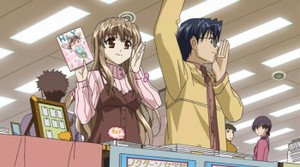
Rating: 2.5 (of 5)
Review:
All right, Haruka, here's your second chance. Prove to me that you're still the charming romantic comedy that you were last summer, and maybe we can still be together.
This episode opens with the weary, much-overused gag of "it sounds like they're having sex but they're really not," which suggests that we are fast approaching the mediocrities of Episode 1. But unlike Episode 1, which dragged itself through the hot springs cliché muck for far too long, this one saves itself by bringing in the supporting cast (Haruka's overreactive dad is always good for a laugh, while her little sister is always good for a nervous, is-this-morally-acceptable laugh) and launches much sooner into interesting material. We find out that Haruka and Yuuto's moans and groans were actually the sounds of a doujinshi in the making, as the pair are putting together a fancomic based on the hit lacrosse anime that's taken Japan by storm.
(For the record, I still think Clumsy Aki-chan from the first season was better.)
Then comes the real meat of the episode, where Haruka and Yuuto set up shop at a small-time convention. Those who are mildly familiar with the world of Artist Alleys will knowingly grin at this scenario—isn't there always some wannabe artist who, despite her utter lack of skill, drags herself and her poor, beleaguered boyfriend to every single convention?
Yet somehow, this situation doesn't turn out all that funny—you start to feel a little sorry for Haruka, and then Yuuto has a spiritual awakening and realizes that the experience of creating a doujinshi is far more important than mere sales figures. Thus we get our predictably sappy ending and cookie-cutter moral lesson, accompanied by way over-the-top syrupy music and one last parting shot of cheesy, trashy comedy.
Maybe the appeal of the first Nogizaka Haruka was that it was able to rise above the low expectations of the genre. But now that we know what the series is capable of, seeing all these play-by-number romantic situations and the clunky animation that goes with them is something of a letdown. Although the series still has its moments, it'll never again capture the unique chemistry of Haruka and Yuuto falling in love for the first time.
Fairy Tail
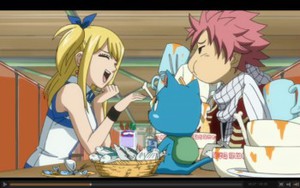
Rating: 3 (of 5)
Review:
The shounen anime of the season is here! Fans of [popular but overrated manga] can finally look forward to seeing [name of hero] in animated form, accompanied by [attractive butt-kicking female companion] and [comical animal sidekick] as they make use of [fantastical ability that would never work in the real world] to fight for what's right.
This fall, these blanks are filled in by the following: Fairy Tail, Natsu, Lucy, Happy, and magic. Episode 1 introduces the characters in standard fashion, with Natsu and Lucy crossing paths when a sneaky wizard named Salamander comes to town. Aspiring wizard Lucy hopes to join the illustrious Fairy Tail guild, and when Salamander claims to be a member, she thinks she's found her way in—only to discover that Salamander is a lying cheat, and that Natsu is the real Fairy Tail member. A raging battle ensues, Lucy reveals her summoning magic, Natsu reveals his fire magic, and anime retailers everywhere can start clearing their shelves for the inevitable flood ofmerchandise.
With its distinctive, likeable characters and a premise that just screams of everyone's childhood dreams, this series fulfills the obligatory action-adventure quota. The first half is also dotted with its fair share of goofy comedy—mostly due to Salamander's womanizing ways—which keeps things from getting boring until battle time. Unfortunately, battle time is something of a letdown, as glowing pink energy beams and computer-generated magic circles seem like a pretty cheap way to represent the wizardly arts. In addition, those who enjoy Fairy Tail because of manga-ka Hiro Mashima's perspective-bending abilities and intense attention to background detail will find none of that here. Much of the manga's visual charm is lost, as most anime studio wage slaves can barely draw regular perspective and they sure as hell won't take the time to fill out the backgrounds.
But of course, A-1 Pictures already knew that, and they knew that the series' predominantly young audience wouldn't be too fussed about that kind of stuff anyway. Just follow the premise of the manga and fill in the parts where the characters talk, move and fight, and you've got yourself the shounen anime of the season.
(And how about that bouncy ending song?!)
Yumeiro Patissiere

Rating: 2 (of 5)
Review:
What is the meaning of this? Were they trying to get an anime version of Kitchen Princess green-lit, but negotiations just weren't working out, so they went with the next closest ripoff instead? That's the only possible explanation for Yumeiro Patissiere, a baking-themed series so rife with clichés that it's hard to tell where the plagiarism stops and the actual show begins.
Our story begins with Ichigo, a middle-school student who considers herself average at just about everything. Seriously, when every single school-age protagonist matches that profile, you have to wonder, what does Japan do with all their gifted and special-needs kids? Do they throw them into the bottom of the ocean? In any case, Ichigo soon learns that she may have a special skill after all. While attending a pastry expo with her family, she notices that one of the cakes tastes exactly like her grandmother's, and then discovers that the cake's creator—a tall, handsome young Frenchman named Henri Lucas—studies at the same culinary arts academy that Ichigo's grandma went to! And of course, Henri is so utterly wowed by Ichigo's perceptive sense of taste that he immediately invites her to study at that same academy. Her family, so overcome by the sheer predictability of this premise, decides to let her go study in France so that they can live their lives and stop having to cater to this cookie-cutter plot.
Klutzy normal girls. Exquisitely crafted desserts. Unexpected special skills. A childhood memory with a beloved relative. Hot foreign guys who are good in the kitchen. This isn't an anime (or more accurately, an anime adaptation of a manga)—it's the result of focus group research on Japanese girls aged 6-11. The animation is barely serviceable, the music is a shallow afterthought cobbled together from the remains of rejected pop songs, and even the character designs seem to be the accumulated average of every shoujo manga character of the last 10-15 years. If this is truly the honest creation from the bottom of an artist's heart, then I feel sorry for a heart that has been completely infected by the mass-media marketing machine. Then again, on the plus side, it'll probably sell a ton of toys.
Tegami Bachi: Letter Bee (Episode 2)
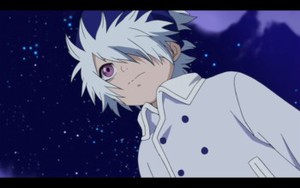
Rating: 3.5 (of 5)
Review:
Some have described Tegami Bachi as being "steampunk." But, with levels of Internet Drama being what they are today, a cautious fan must ask, what does steampunk even mean? Does it mean battling low-budget CGI monsters with magical spirit guns? Does it mean making schmaltzy dramatic speeches every ten minutes? Does it mean imitation J.S. Bach constantly playing in the background, all tinkly flutes and harpsichords, even though Bach was a century and a half too early for the era of Jules Verne and H.G. Wells?
Stylistic trappings aside, Tegami Bachi's second episode finishes the job that was assigned in Episode 1—letter carrier Gauche Suede finishes delivering his human cargo, Lag Seeing, to a far-off destination in the land of everlasting night. Along the way, Lag's remarkable secret (which explains his unkempt hairstyle) is revealed, and the emotional bond that has developed between Gauche and Lag prompts the boy to become a Letter Bee himself. Skip five years, and that's where the real story begins.
The mood of the series remains consistent with the opener: lots of trekking across open land, a sense of wonder everytime the camera pans across the starlit sky, and subdued color schemes designed to soothe the soul. In its attempt to be deep and meaningful, however, this episode lays it on pretty thick with Gauche's platitudes about his sense of duty and the meaning of friendship—but then again, maybe those long-winded speeches are the only way to get the point across. Later on, in its attempt to be intense and action-packed, the episode errs in the other direction and gives us a brief, clumsy battle with another awkwardly animated Gaichuu (or maybe everything just looks inferior now after watching Darker Than Black).
Despite these missteps, however, the appeal of the series remains. Every scene breathes with the spirit of adventure, and the characters are likeable without having to resort to ridiculous behavior or cheap stereotypes. They're just trying to survive in a tough world, much like we are in our daily lives. And isn't that worth much more than fussing about the meaning of steampunk?
Darker Than Black 2: Gemini of the Meteor

Rating: 4 (of 5)
Review:
The lead character of Darker than Black 2 is a young female with big eyes. That makes it brain-dead moe trash! Moe is the ENEMY! Darker Than Black should be taken out to the backyard and shot!
Okay, irrational knee-jerk reactions aside, it's a known fact that Studio BONES raised the bar for the supernatural-power-battling genre with the original Darker Than Black. So what to do for a sequel? New characters, new powers, and a first episode that hooks you in with a particular atmosphere ... and then shatters that atmosphere with a five-minute finale of heart-pounding action.
The story goes something like this: Suou and her twin brother Shion have been living separately (at least when their dad can enforce it) ever since Shion gained "contractor" powers from a meteor strike two years ago. Other than that, Suou has been living a relatively normal teenage life—but that's all about to change when Bad Guys In Dark Suits show up to forcibly take Shion away. A thrilling escape and an intense gunfight ensues ... and we're right back to what BONES does best.
The hidden gem of this episode, however, may be the first half where we see Suou hanging out with her friends from school. It's just pure youthful bliss, coupled with a tuneful insert song and lively character animation that proves you don't have to enter the realm of special powers and fancy weapons to be visually interesting. It's a sequence that makes viewers care about the characters, and makes it much more engaging when the bad guys eventually show up to turn everything around.
And turn around it does. The soundtrack switches style and picks up the pace, badass special agents and scientists fly across the screen, and people start ripping up the Russian countryside with their amazing powers. Look at the Flash-animation-sliding-across-the-background gunplay in something like Kämpfer, and then compare that against the jaw-dropping bullet-time sequences in this series. The difference is clear: the action-adventure bar has just been raised again.
Kimi ni Todoke
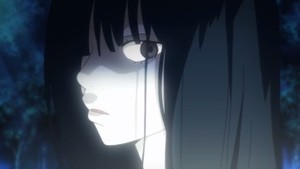
Rating: 3.5
Review:
Poor Sawako. Her long hair and creepy aura have prompted her classmates to nickname her "Sadako," people are afraid to be friends with her, and she's stuck in one of those mundane school-life shoujo storylines where everyone is really pretty and the boy of your dreams falls in love with you. And that's the problem with Kimi ni Todoke: like other series of its kind, the awesomeness probably doesn't show up until much later down the road, when you've grown attached to the characters and the story is ready to drop a few emotional bombshells. By comparison, the first episode is merely a shallow affair, introducing the main character, her love interest, and sending them on some customary school activity (in this case, a nighttime "test of courage").
But wait! Who's responsible for this? Was that Production I.G's logo in the credits just now? Ghost in the Shell and Moribito and Eden of the East Production I.G? This is like inviting Lebron James over to your house to play darts and discovering that, thanks to his superhuman athletic abilities, he can kick everyone's ass at darts the same way he kicks everyone around in basketball. To put it in anime terms: the attention to detail, the eye-catching watercolored backgrounds, the flawless gesture animation, and the sure-handed directing that are I.G's trademark in their action-adventure titles all transfer seamlessly to a sentimental high school romance. Heck, they even brought in S.E.N.S. to do the soundtrack, resulting in a captivating musical atmosphere that is best described as xxxHOLiC in a major key.
Which is not to say that this episode doesn't have its flaws. Sawako almost runs the script into the ground with her constant monologues, and dreamboy Kazehaya is practically a non-character whose main purpose is to stand around looking cool and say nice things to Sawako. The animation also gives in a little too easily to indulgences of super-deformed style, which is cute as all get out but also distracting. That's okay, though—with the stellar visuals already having caught everyone's attention, all we have to do now is wait until about early 2010, and by then people won't be able to shut up about how amazing Kimi ni Todoke is.
Kobato
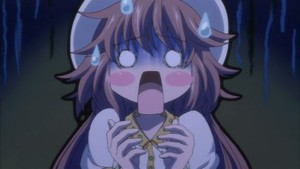
Rating: 3.5 (of 5)
Review:
First-episode performance is not an indicator of future results. This holds especially true for Kobato, which spends the full half-hour on the titular heroine's origin story. Kobato Hanato is a well-intentioned but thick-headed young girl who wants to fulfil a wish, but in order to do so, she must heal the hearts of others and collect their sufferings in a magical bottle. Along the way, she also receives the sarcastic guidance of a blue plush-toy dog named Ioryogi. Based on this scenario, the series is either a ridiculous amalgam of fairytale dreck or a poignant slice-of-life with fantasy elements. It's CLAMP; you figure it out.
Unfortunately, Kobato doesn't get her bottle until the end of Episode 1—which creates a disconnect between what's happening right now and what's probably going to happen in the rest of the series. The entire first episode seems to be a psychological test designed to weed out viewers who have a low tolerance for scatterbrained protagonists and ornery sidekicks. Kobato spends the entire first half failing at mundane tasks, getting yelled at by Ioryogi, and switching so rapidly between her regular character design and chibi style that the seizure episode of Pokemon may have finally met its match. It's like they're saying, if you don't like this kind of stuff, run away now!
Good things come to those who wait, though: in the final third of the episode, Kobato breaks out the power of song, which apparently also means summoning an invisible orchestra and a perfectly choreographed flurry of flower petals. It is pure, unapologetic musical and visual indulgence, and let's face it, most fans are going to fall for it hook, line, and sinker. You're going to forgive Ioryogi's attitude problem, Kobato's failure at life, and the ridiculous changes in artistic style because, man, those last few scenes are just so sweet and beautiful and the healing power of music trumps everything. A healing power that, in fact, extends to the pleasant light-classical soundtrack and Maaya Sakamoto's breezy opening theme. The origin story of Kobato is an irritating one, but the heartwarming finish makes it easier to let go of that irritation ... and hopefully give the series a chance.
Nogizaka Haruka no Himitsu 2 -Purezza-
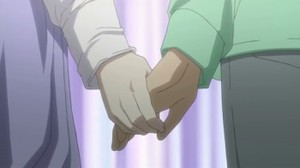
Rating: 2.5 (of 5)
Review:
Here's the real secret of Nogizaka Haruka no Himitsu: despite the fanboy-bait wish-fulfilment scenario of dating the hottest otaku girl in the country, the original series turned out to be surprisingly sweet and charming. So naturally, we ask ourselves: does the sequel capture that same charm?
Early signs point to no. With the happy couple of Yuuto and Haruka already well-established, and having run the gamut of adorable geek dates in the first series (namely Akihabara and Comiket), there's nothing left to do but cycle through the usual romantic-comedy drivel. First up: hot springs resort. Ugh. Well, it's probably best to get it out of the way now so that people don't have to sit through it in Episode 6 or whatever. It's just one predictable scene after another, with Yuuto and Haruka's schoolmates scheming to get them together, followed by Haruka and her girlfriends frolicking among strategically placed clouds of mist, and an embarrassed Yuuto having to sneak his way out of the baths when he accidentally ends up on the girls' side. How on earth did they make this episode—Windows Movie Maker and lots of copy-pasting?
The shoddy animation quality lends even more credence to the Windows Movie Maker theory; the clunky linework, simplistic character designs and stiff gestures all point to evidence of a production that was done on the cheap (or preferably, free). Heck, Haruka is supposed to be the most attractive character in the show and even she looks like a bargain-bin bishoujo from certain angles. = In fact, I'm not sure what even possessed me to state that the original series was sweet and charming, considering the sheer mediocrity of—
Oh wait.
The day after the hot springs incident, Yuuto and Haruka and friends are strolling around town, and he gallantly sneaks her off to an anime event just to be together? While gloriously sappy ballad music plays in the background and they stare sweetly into each other's eyes? Why, this is just ... !!!
How dare you, Nogizaka Haruka no Himitsu! How dare you make me fall in love with you all over again!
Sora no Otoshimono
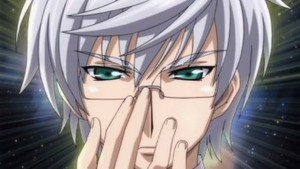
Rating: 1 (of 5)
Review:
Pink-haired girls have never really done it for me. The only one I ever really liked was Amu from Shugo Chara!, and that's half because of her outspoken personality and sense of style. So when a pink-haired pair of boobs falls out of the sky and starts granting wishes to a developmentally challenged schoolboy, that's the cue to run and hide from the unprecedented levels of lameness that are sure to ensue.
Unfortunately, there's still the rest of the episode to review, so here it is.
Our pathetic schoolboy is a lad named Tomoki, who (cliché alert!) keeps having strange dreams about a beautiful girl disappearing into the sky. That's why his (cliché alert!) classmate who wakes him up every morning, Sohara, encourages him to talk to the school weirdo, Sugata. Naturally, Sugata suggests that this is all due to (cliché alert!) an alternate world that will make contact with their hometown under the sacred cherry tree at midnight tonight. As luck would have it, a pink-haired angel named Ikaros falls to earth and (cliché alert!) starts catering to Tomoki's every whim, causing him to engage in all sorts of cringe-worthy, perverted behavior (at which point anyone with taste would have quit the episode already). Eventually, Tomoki screws up the entire world, but manages to undo the damage just before the ending credits roll. But it is too late. Because this series has already damaged all the viewers who made the mistake of watching it.
There is at least one moment of artistic merit in the opening episode, and that's when Ikaros actually drops from the sky and the animation staff just goes nuts with fantastical imagery and special effects. "Everything else in this show is garbage," they say, "so please let us indulge in this one moment of wind and feathers and sparkles to make it the greatest angel-falling-to-earth scene ever!" But everything else, from the cookie-cutter character designs to the generic small-town setting to the bland sentimental music, is perfectly calculated to bore discriminating viewers out of their minds. You know, at least Ah! My Goddess had Norse mythology and quantum physics and mechanical engineering in it. This only has the suffering of a thousand souls.
Miracle Train
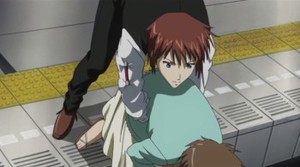
Rating: -3 (of 5)
Review:
Bishounen are the cancer that is killing Japanese animation.
At the same time, though, I don't begrudge Miracle Train for its hot male personifications of famous Tokyo train stations—after all, there is already railway moe in the form of Tetsudou Musume, so it's only fair. However, designing a handful of attractive characters is not the same thing as actually putting those characters to good use, and this is where the series does a fairly spectacular job of crashing and burning.
Now, I don't know about other young women, but if I stepped into an empty train car and was suddenly greeted by six handsome gentlemen offering their "services," I would freaking scream for the police. But not in the world of Miracle Train, where Episode 1 protagonist Chinatsu decides that it would be best to let these gorgeous hunks assist her in finding her dog, who scampered off earlier in the episode. And this is what happens for the next twenty minutes: hot guys on a train talking about finding a dog, or discussing various points of Japan Railway trivia, or offering Chinatsu some emotional support. The episode reaches its pinnacle of dreckiness when Chinatsu imagines a terrible world where her dog dies, leaving her all alone with nothing but the strains of weepy violin music to accompany her. For God's sake, woman, didn't you watch Tokyo Magnitude 8.0? Your sorrow is nothing compared to what Mirai had to live through! And then it turns out that her dog was at the original station the whole time. Thanks a lot, Mr. Roppongi and friends, you wasted that poor girl's time riding back and forth on the Oedo line.
As a pure eye-candy type of show, it's no surprise that the men of Miracle Train are beautifully rendered and everything else drops off steeply after that. There's barely any animation to speak of—almost everything can be reduced to pure dialogue, apart from the final dog-rescue scene—and since the entire episode takes place on a train or in a train station, it is about as visually interesting as taking public transport. Wait, it IS about taking public transport. Excuse me while I throw myself onto the tracks.
Seitokai no Ichizon

Rating: 4.5 (of 5)
Review:
Before it even gets to the opening credits, Seitokai no Ichizon's first episode manages to riff on Kuroshitsuji, Haruhi, Lucky Star, and even takes a passing shot at Dragonball: Evolution. And that is how you know, in the space of five minutes, exactly what kind of show this is. It is also the kind of show that people will classify as absolute garbage or absolute genius. There is no middle.
For years, the student council has been a staple of school-themed anime but was always pushed off to the side, a secondary concern to the adventures of Main Character Who Discovers Amazing Powers. Seitokai corrects this injustice by putting the spotlight on a student council comprised of four girls (who were elected by a regular vote) and one guy (who got in by having the highest overall grades)—and the madness that ensues when the guy, Ken Sugisaki, starts having delusions of grandeur about having his own personal "harem." Sure, it plays off all the old, time-worn school-comedy tropes, but it does it with a wink, a smile, and a heavy dose of hyperactive energy, which can often make up for creative shortcomings. Sugisaki spends most of the episode bouncing off the walls, scheming and trying to use ero-game logic on the girls, making flat-chest jokes, and at one point even yells out "MY WIFE!". Simply put, this guy is either a complete loon that will make you quit the series in 30 seconds, or a hero to young men everywhere.
The girls, on the other hand, are far less interesting as characters. It's their interactions with Sugisaki that really make the show, with lots of attitude and back-talk, and occasional moments of self-reference and parody.
As for art and animation quality? Well, let's be realistic about this: the whole thing takes place inside a school clubroom. The main "action scenes" involve Sugisaki getting pummeled for his verbal gaffes. The character designs are just standard templates slotted into remarkably ugly uniforms. And the background music could have been written by a composer during coffee breaks. Yet despite all the trappings of a low-budget production, these kids are going to make you laugh.
The Sacred Blacksmith
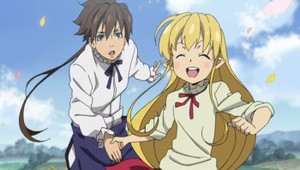
Rating: 3 (of 5)
Review:
The first episode of The Sacred Blacksmith doesn't really get 3 out of 5. What's actually happening is, the last few scenes rank an impressive 4-to-4.5-ish, while the rest of the episode gets a depressing, generic 2. This is a fantasy tale of cookie-cutter proportions, where a knight named Cecily Cambell is striving to establish her name as a defender of the merchant town where she lives. This involves getting into a fight in the marketplace, being humiliated when a more experienced (and handsome) swordsman bails her out, then realizing that she has to visit that same stuck-up swordsman in order to have her weapon repaired.
If, at this point, you aren't lying in a pool of your own blood after slitting your wrists out of boredom, it's time to play everyone's favorite game: Guess the source material of this adaptation!
Is it:
a) an RPG video game
b) a fantasy manga
c) a light novel series
d) an erogame
e) something an anime director wrote on his napkin over drinks on a Friday night
If you guessed (c), congratulations! This is exactly the kind of thee-thou-thine drivel that makes Renaissance Faires and LARP societies what they are today.
Still, the series deserves points for its quality presentation: the crisp linework, the vivid colors, the carefully thought-out character designs (who wants to bet they have a guy whose job is just to draw the trim on the armor?), and consistently smooth animation. A rich orchestral soundtrack adds the final touch, as if to say, "Hey, this is a totally generic fantasy series, but we might as well throw our heart and soul into it!"
The real heart and soul, however, comes when Cecily and Hot Swordsman (actually, his name is Luke) have to fight a much more powerful monster in the woods. Suddenly the animation quality jumps through the roof, the action and special effects come crackling through, the music soars, and Luke's secret is revealed in a fountain of golden CGI light: He can forge swords with magic.
And suddenly, after 20 minutes of thee-thou-thine drivel, you really, really want to watch Episode 2. Admit it.
Tegami Bachi

Rating: 3.5 (of 5)
Review:
The big knock against Tegami Bachi is that it's not Hiroyuki Asada's Tegami Bachi. Oh, it still has Asada's general concept—the stark twilit scenery, the intrepid letter-carriers braving said scenery, the wistful tales of human interest that accompany each delivery—but like any anime series, it has been forced to sanitize the striking manga style in order to make the artwork animatable.
That said, sanitized Hiroyuki Asada is still better than non-sanitized everyone else.
After all, the one thing missing from the manga is motion and color, and this series delivers that aspect eminently: Episode 1 makes sure to indulge in all the little details of the world of Amberground, from the wrinkled mountain peaks to the twinkling stars to the vast expanses of desert. It takes the cheap way out with the local wildlife, though, animating the "Gaichuu" (giant armored insects) in painfully obvious CGI. No such shortcuts are taken with the main characters, though—the snazzy retro-cool outfits are rendered down to the last button, and the special effects that go into firing a "shindanjuu" (a magical gun that exterminates Gaichuu) are top-notch.
Visual appeal is only one part of the equation, though, and things look a little less impressive after digging into the details of the story. Gauche Suede is a Letter Bee (that's fancy talk for "postman") tasked with the job of delivering a little boy, Lag Seeing, to a distant town on the butt-end of the world map. This involves trekking across the lovely scenery, fighting off Gaichuu, having flashbacks about Gauche and Lag's troubled lives, and ... that's about it. Look guys, taking the slow scenic route is nice when you're on vacation, but as far as creating a compelling anime series, that may not be the best approach.
Still, it's hard to complain about the general mood of the show, which just plain works—Suga Shikao crooning the opening, a subtle soundtrack to accompany the shadowy landscapes, and the tale of a young man with a past trying to make his way in the world. For a combination like that, sanitizing Hiroyuki Asada's artwork is but a small price to pay.
To Aru Kagaku no Railgun (A Certain Scientific Railgun)

Rating: 3.5 (of 5)
Review:
If there's one thing that Bioshock, Infamous, and even Heroes have taught us, it's that electrical superpowers are awesome (and preferably, someone as hot as Kristen Bell should wield them). To Aru Kagaku no Railgun doesn't have Kristen Bell, but it does have Misaka, the charismatic instigator who zapped her way through To Aru Majutsu no Index and probably became everyone's second favorite girl in the series after Index—if not Number One.
As such, this spinoff title eschews introductions and goes straight into the fun stuff: using psychic abilities to beat up bad guys and hanging out with friends from school. And then beating up more bad guys. All right, so it doesn't have the immediate tension and cliffhanger-iness of Index, and the middle bogs itself down with doofy school-time activities (did we really need that shower scene?), but it's a comforting return to the ultra-modern locale of Academy City, where psychic abilities are commonplace and paranormal research is an established scientific discipline. Yes, this all sounds like so much drivel from the "I have amazing powers!" school of genre fiction, but the fact is, the world of Index/Railgun pushes it to a high enough level that it's pretty appealing stuff.
Part of that appeal comes from the characters: super-athlete Kuroko may be a high-pitched pain in the bucket, but is offset by Misaka's own forceful personality, providing a well-balanced primary friendship as well as the occasional Misaka-fangirl gag (apparently everyone is in love with her because her powers are ranked among the highest of the general population). The other big plus is when this episode clicks over to full-action mode: it's just pure visual delight when Kuroko goes all out with flying kicks and high-speed maneuvers, while Misaka's zapping of a would-be criminal showcases some fancy animation technique. Any fool can trot out special effects, but picking the right sequence of camera angles is the work of a well-trained artistic eye. Layer some hot techno-pop tracks on top of that, and it's clear that Railgun is picking up right where Index left off. Same old psychic-power battling genre ... but with a dose of cool.
Book of Bantorra
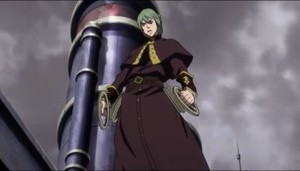
Rating: 2.5 (of 5)
Review:
In all honesty, the only reason I've even heard of Book of Bantorra is because Mariko Shinoda did some cosplay promotion for it.
Oh Mariko, you are so lovely.
This anime, on the other hand ...
Well, it does a few things right. The retro-twentieth-century setting is beautifully sketched out, with distinctive costumes and lavish backgrounds; in addition, the general idea of the series—dead people's souls being turned into books, and a troupe of Armed Librarians guarding them—is definitely a shade more intriguing than the same old "We're special-powered people who fight for justice because that's what we do." But that's about where the awesomeness stops. Once the basic concept is laid down, the series goes bonkers trying to fill in the details, resulting in a confounding first episode where the evil "Shindeki Church" is on a "boat," controlling an army of semi-braindead humans called "Meats," and it's up to the psychic super-squad to stop the "Meats" before they try to kill the mysteriously sexy lady "Hamyuts Meseta," who is on a cliff watching the proceedings because apparently this doesn't make any more sense to her than it does to the viewers. Oh, and watch out for blindingly bad sea-vessel CGI!
Eventually, one of these Meatheads drifts off into a seedy little town where he may or may not end up becoming a pivotal character, while the Armed Librarians discuss whether they managed to pick up any good books from the assault on Shindeki.
Basically, the problem with Book of Bantorra is that it's like going to this great guitarist for lessons, and you can tell that his technique on the instrument is amazing, but as soon as he tries to explain anything to you it becomes an exercise in frustration and you feel like you'll never get any good at the guitar at all. Bantorra overwhelms itself with jargon words, too many characters with too many silly names, multiple subplots that go unexplained, and a lack of impetus as to why we should keep watching besides just looking at awesome psychic-power fights and people in cool-looking outfits. Alas, if only Mariko had been chosen to promote a series that was more coherently put together.
Kämpfer

Rating: Are we allowed to use imaginary numbers? (of 5)
Review:
Kämpfer may very well be the ultimate coming together of high-concept: in one fell swoop, it marries "ordinary high school guy discovers he has amazing powers" with "ordinary high school guy hangs out with way too many cute girls," which pretty much sums up everything that needs to be said about contemporary anime. Then, just to add the final flourish, he switches gender when his amazing powers activate.
Also, lots of umlauts.
The use of German is Kämpfer's one touch of exoticism, but otherwise, the first episode plays out like everything else in the genre. Our hero, Natsuru, wakes up one morning to find his stuffed tiger telling him about his secret abilities as a "Kämpfer," which is German for "you have to turn into a girl to use your powers because the plot says so." As luck would have it, Natsuru has to use his Kampf-ing skills (shooting fireballs out of his hand) on the way to school when a redheaded, gun-wielding Kämpfer comes after him. But wouldn't you know it, the redhead's true identity is actually Natsuru's mild-mannered schoolmate Akane! Will wonders never cease?
No, wonders do not cease, because it is also revealed that Natsuru's crush—the eminently beautiful and generic-looking Sakura—has fallen in love with the fireball-shooting girl version of Natsuru. Wow, you guys, it's like Ranma 1/2 except horrible.
Even the half-decent production values provide little comfort for the viewer: yes, it's true that you can watch the animation without clawing your eyes out, and the tuneless dinky-pop soundtrack can be tuned out after several minutes, but the overall sense of design is pulled straight from a library of stock characters and backgrounds.
I once saw this ridiculous "How to Draw Shoujo Manga" manual that contained a CD-ROM full of clipart and accompanying instructions on how to cut-and-paste the images to form the most awful-looking comics ever. I greatly fear that Japan may have come up with a similar "How to Create Action Anime" kit—and that professional studios are actually using it.
Queen's Blade: Gyokuza no Tsugumono
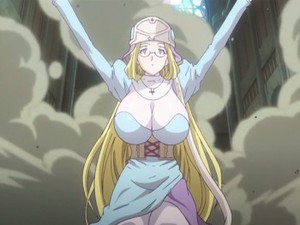
Rating: 1 (of 5)
Review: FACT: This series is still awful.
In a world where Kate Minus Jon Plus Eight still exists, however, it's easy to see why Queen's Blade has earned itself a sequel series. This is a title that has it all: violence, porn, and violent porn, including everyone's favorite, the girl who shoots acidic milk out of her breasts. The premise is the same as it always was: impossibly-endowed warrior women battle in a legendary tournament called "Queen's Blade," with the winner being named Queen of all the land. (And you can repeat this infinitely many times, because everyone wants to usurp the Queen, of course. Just imagine ten years from now when anime fans will be drooling over the babeliciousness of Queen's Blade: Diamond and Pearl.) Episode 1 gets off to a clumsy start, with the warriors from the original series showing up and recapping their accomplishments through a number of dull dialogue scenes.
Oh, it tries to make things interesting—the character designs and color schemes seem more polished than before, and the recaps manage to get off a good number of boob-and-panty shots—but the only thing more boring than endless fight scenes is people talking about endless fight scenes they had in the past. Things pick up in the second half, especially with Acidic Milk Girl daring to take on the reigning Queen, but that battle ends up being a fairly quick blowout, with very few moves that would actually make action fans sit up and take notice. Presumably, the better fights (which will showcase the improved animation budget) are going to show up later, but there's just too much going against this series right now: it's only worth continuing if you had the stomach to sit through the first one, the plot is as ridiculous as ever, the mammaries are as ridiculous as ever, and any attempt at creating an interesting "twist" (Nanael the angel is entering the tournament?!!) just feels gimmicky. On the plus side, the pompous epic-fantasy music is still way better than it deserves to be. But that's about it.
discuss this in the forum (327 posts) |
this article has been modified since it was originally posted; see change history
back to The Fall 2009 Anime Preview Guide
Season Preview Guide homepage / archives